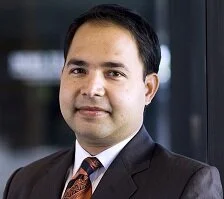The campus of The University of Texas at Austin. The new director of its Energy Institute is Varun Rai. Photograph courtesy Energy Institute
At the Helm
By Hillary Hoppock
May/June 2019
Varun Rai, the new director of the Energy Institute at The University of Texas at Austin, examines the social, institutional, economic and technological components of energy systems.
Varun Rai, the new director of the Energy Institute at The University of Texas (UT) at Austin, is a pragmatic scholar with a background in engineering and energy policy, as well as a reputation for innovative interdisciplinary research.
Rai has taught courses in statistical analysis and learning as well as energy innovation at the Lyndon B. Johnson School of Public Affairs. “Energy is perhaps more important today than it has ever been in the history of the world,” he says on the university website. “Led by outstanding faculty across multiple schools, centers and departments, UT is a world leader on energy research. There is so much incredible work happening across campus, spanning innovations in oil and gas, renewable energy and next-generation storage technologies.”
Rai studied mechanical engineering at the Indian Institute of Technology Kharagpur and received a doctorate in the subject from Stanford University, California. He takes a global perspective on energy systems and policy, and sees energy research at UT Austin playing an important role in a world where energy access is far from universal and the impacts of climate change are already unfolding. “I am thrilled to have the opportunity to shape the Energy Institute into a valuable asset for supporting and elevating pathbreaking energy research at UT for a better Texas, a better United States and a better world,” he says.
Practical research
Rai’s academic research has focused on four themes across global energy systems: capital-intensive energy technologies like carbon capture and storage (CCS); demand-side energy technologies, like solar and electric vehicles; energy technologies in emerging markets like China and India; and lead markets for supporting novel energy technologies.
All of which, he acknowledges, must be grounded in one practical question: “How do new promising energy technologies invented in the lab actually make it out into the world at scale?”
This is where the interdisciplinary approach to research comes in. The invention of new technologies and solutions to address problems, like energy access and global climate change, is only step one in the evolution of a new technology. “For achieving high penetration of new technologies in the real world, excellence in engineering is necessary, but not sufficient,” says Rai. “Achieving high market penetration is also dependent on social and cultural norms, regulation and the dynamics of the marketplace, including supply-side competition as well as customer behavior. Our research needs to address the behavioral, economic and informational barriers and look at the related infrastructure, incentives and policy support in the broader socio-technical environment.”
To that end, Rai’s research group at UT, called the Energy Systems Transformation Research Group, has created a powerful modeling and simulation framework to represent and analyze the complexities of energy demand. It provides the ability to represent behaviors of energy consumers and model the interaction with other social, technical, economic and policy factors influencing energy demand. This framework is designed to help develop effective public policy approaches to increase adoption of low-carbon technologies at scale over time.
There is a sense of urgency in his work. “We have to move very fast in confronting climate change, impacts of which are already beginning to manifest,” says Rai. “Meanwhile, it takes years, and even decades, for new energy technologies to find footing in the marketplace.” He recognizes other hurdles in the process. “There is a general expectation that with experience, technology costs will go down,” says Rai. However, due to the complexities of some technologies, like CCS, and associated value chains, there is no guarantee that the cost will necessarily come down; it might just go up. Careful design of learning and interaction processes between generations of a technology as well as paying close attention to social, political and customer interests are absolutely critical.”
Energy Institute
In addition to his academic career, Rai worked as a commissioner for the electric utility Austin Energy. “I gained experience in the practical aspects of public policy. It gave me a feel for the ideas and interactions of a large utility with the public and society,” he says. He founded the UT Energy Symposium, a weekly guest lecture series by acclaimed energy experts that is open to the public. “It is a forum for discussing issues around energy, which, admittedly, can sometimes be contentious. It is important to have that open space for discussion and involve our students, researchers and the public,” says Rai.
In his role at the Energy Institute, Rai is confident that UT will continue to strengthen its leadership in collaborative interdisciplinary energy research and help decision-makers deal with the realities and challenges of the rapidly-evolving global energy systems.
He sees his job as helping connect the dots among the already-excellent energy research capabilities at UT to “think about global issues, ask big questions, develop a focus and identify a few of the challenges where we have the best and strongest interdisciplinary expertise to contribute.”
Hillary Hoppock is a freelance writer, former newspaper publisher and reporter based in Orinda, California.

